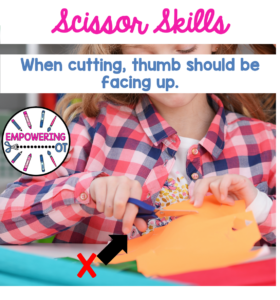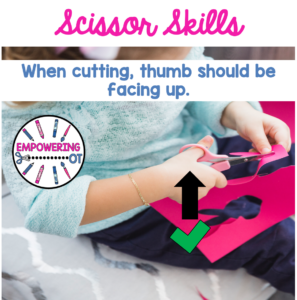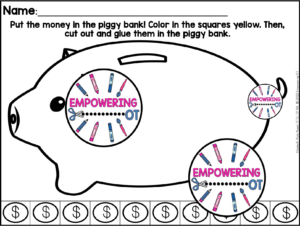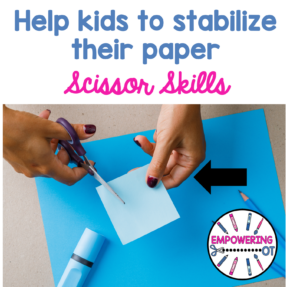Snipping paper is an essential first step to start cutting. There are many essential skills that children need when they are learning how to snip.
Difficulties you might see when students are learning to snip:
- Holding the scissors with their forearm in pronation (with palm floor). This prevents students from cutting as the scissors are facing at an angle where it is hard to cut with scissors.


- Being unable to open and close the scissors. Students may keep the scissors closed and be unable to open the scissors to cut. This could be due to the fact that children have not developed the motor pattern of opening and closing their fingers. They may have difficulty with motor planning and figuring out how to make their fingers move open and close.
The first step is to start without scissors. What? This sounds counterintuitive. However, starting with scissors can be very, very, challenging for young students. It is essential to work on activities that support snipping.
Activities related to flexion and extension of their fingers.
While children are performing these activities, have them hold a stabilizing object with their non-dominant hand to mimic holding paper. Make sure students are using good form.
- Have your child use tweezers in their dominant hand to transfer mini erasers to a container that is being held by their non-dominant hand.
- Use all different types of tools that open and close, such as clothespins, chip clip bags, chopsticks that have rubbers bands to hold the sticks together etc
- Playing finger movement songs such as baby shark (opening and closing their fingers)
- Picking up items with clothespins
- Using their fingers to pinch small objects, and then releasing the objects.
Activities that promote having a neutral forearm (thumb going up)
- Scooping items using a spoon.
- Using a play spatula to carry pretend food or a bean bag
- Using clothespins, tweezers, etc
- Toys that promote isolation of thumb movement (ie: toy unicorn that opens it’s mouth)
- Finger play: Where is thumpkin?
- Practicing making thumbs up
Once children start to develop these skills, incorporate FUN, INTERACTIVE snipping pages into their routines. For example, snip the coins and put them on the piggy bank or snip the apples and put them on the tree. As a bonus, children will also be working on an important language skill: prepositions (ie: in, on, next to etc) Click here to download this resource in my store!


Looking for more scissor skill tips? Check out my blog post about learning how to stabilize paper while cutting!






